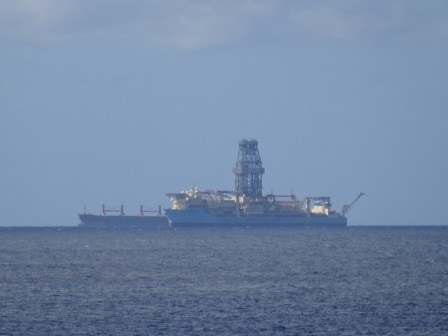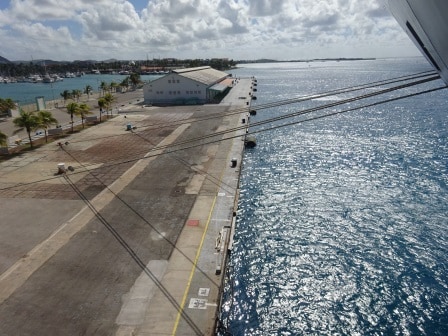The A.B.C islands (Aruba, Bonaire, and Curacao) are located just above the South American North Coast. Hence the good reason why it became a Dutch territory in the 17th. Century. They were very strategic in controlling the area which is now Venezuela, Columbia and the approaches to Panama. The islands itself were useful as well, as sugar cane was cultivated with great success. As both Curacao and Aruba had a natural harbor these two islands were the foremost of the economic expansion when Royal Dutch Shell stated to explore the Venezuelan oilfields. Refineries were built and eventually Bonaire took part in the oil production as well but Curacao with its Schottegat and Aruba with the Paarden Baai had a great advantage. And this remains to until the current day. Bonaire is still the more laidback one of the three islands although it has two cruise piers.
Our overnight cruise has taken us from Curacao all the way to Aruba, about a 50 miles voyage to the west. Even with leaving at 23.00 hrs. in the evening the ship could still make Oranjestad by 06.00 the next morning by sailing backwards. Other ships were dealing with this “backwards sailing” as well. Two cruise ships were going from Aruba to Curacao and as they had left in the afternoon they were already off Curacao by 8 pm. floating for the remainder of the night until pilot/docking time. They could have docked either where the Zuiderdam was or at our dock as soon as we had left but then you have to pay more port fees and you loose on board revenue as a lot of the younger crowd on board those ships would have invaded Willemstad in the middle of the night.

Unusual to see outside Aruba, and there were three of them, were the floating oil drill platforms from Maersk. Most likely waiting for orders.
Our stay in Oranjestad was scheduled from 07.00 hrs. to 13.00 hrs. a short call needed otherwise it would be hard to make Grand Cayman on time. The port of Oranjestad is basically a heightened shore line turning it into a number of berths for ships and those berths are protected from the ocean swell by a natural reef. This all together is called the Paardenbaai or the Bay of Horses. As luck would have it we were the only ship in port today making it possible to dock right in the middle of the cruise pier at Terminal B, which has the shortest walking distance to town.

Most is different from other ports is that the bollards are much more island, giving a much better angle against the wind.
Also the Staff Captain was happy as the ship could put its mooring ropes anywhere it liked without having to share with any neighbors. Putting mooring ropes in the best possible position is of extreme importance in Oranjestad. If the trade wind veers just a little bit to the North East it flows fully in the port beam. The island is very low and thus offers very little protection. The ropes will have to hold the ship in position against the wind which on a bad day can easily climb up to 35 knots. So sometimes the help of the thrusters is needed to ease off the tension on the ropes. The port has a very large number of bollards installed, many more than in any other port and that makes it possible to put ropes ashore which are 90o to the ship and straight in line with the wind. With other ships at the A and C terminal you sometimes have to share bollards and that is never nice. So today was an ideal day for a perfect rope alignment even if the wind was not that strong.
For departure the strong wind is not a problem. You simply employ the “blow away” maneuver. Let go the lines and by the time they are out of the water the wind will have pushed the ship 10 meters or so from the pier and the only thing you have to do is to give full ahead and make one course change to starboard and you are back again in the open sea. Then sail around the west point of the island and from there a northerly course to Grand Cayman.
Here we will be the day after tomorrow. They are expecting five ships in port and if they all show up, the Oosterdam will have to drift. This means more work for the captain but for the guests it is not too bad as we can drift right outside the tender port reducing the tender distance to the port to the absolute minimum. The weather for tomorrow, more of the same with maybe a bit more swell as we will be out of the lee of the islands.

December 5, 2016 at 5:42 pm
As an aside comment, the Royal Dutch Petroleum “Eagle” refinery was rather small and just outside Oranjestad. On the other side of the island, there was a very large refinery called the “Lago”, and owned by Standard Oil of New Jersey, then called “Esso” but now known as Exxon. It was at one time the second largest refinery in the world, mostly refining, and then shipping oil from Venezuela to the US. Just Sayin…………Ruud
December 6, 2016 at 8:49 am
Hi Captain Albert:
I have been following your blog since we booked the Koningsdam in January, we disembarked on Dec.4th after a wonderful cruise.
I did the behind the scenes tour of the ship, although it covered the ship from top to bottom we did not see the M.O.B. We walked the promenade deck daily and I do not recall seeing it – where is it ?
Thanks
Murray & Pepe
December 6, 2016 at 4:19 pm
Glad you enjoyed the ship and thank you for reading my blog.
The answer is very simply. It is not there anymore, at least not in the shape of what we are used to the Fast Rescue boat which,looks like a speed boat. Although it was fast, it had one problem, it could not take sufficient crew on board. We like a medical person to with us and these boats do not have the room for medic, supplies and stretcher. So the Koningdam has boats 5 and 6. Regular lifeboats but with fast winches and a bow thruster for optimum maneuvrability.
I hope this answers the question:
Best regards
Capt. Albert
December 7, 2016 at 2:36 pm
Question answered, thanks.
Murray
December 7, 2016 at 7:36 pm
Thank you very much for this interesting bit on the Dutch ocean-going history, Captain.
Did you not see any traditional real fun festivities around this date of 5 December in Oranjestad (Aruba) this year, Captain?
December 8, 2016 at 3:35 pm
I did not go ashore, but I did not see anything from the ship. The ship did buy the pepernoten (pepper nuts) for all the Dutch on board here.
Best regards
Capt. Albert
December 10, 2016 at 9:09 pm
There were pepernoten? And I missed them, darn! I am enjoying reading your posts on the cruise we have just completed. Very interesting to read about it from a non-passenger point of view. Thank you!